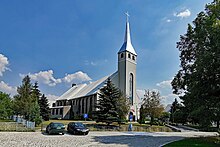Trzebiel
| Trzebiel | ||
|---|---|---|

|
|
|
| Basic data | ||
| State : | Poland | |
| Voivodeship : | Lebus | |
| Powiat : | Żarski | |
| Gmina : | Trzebiel | |
| Geographic location : | 51 ° 39 ′ N , 14 ° 50 ′ E | |
| Residents : | 1342 (March 31, 2011) | |
| Postal code : | 68-212 | |
| Telephone code : | (+48) 68 | |
| License plate : | FZA | |
| Economy and Transport | ||
| Street : | Droga krajowa 12 | |
| Next international airport : | Poses | |
| Wroclaw | ||
Trzebiel [ ˈtʂɛbjɛl ] ( German Triebel , Sorbian Trjebule ) is a village in the powiat Żarski of the Lubusz Voivodeship in Poland . The place with around 1350 inhabitants is the seat of the rural municipality of the same name with around 5750 inhabitants. Most of the municipality belongs to the Polish part of Niederlausitz .
Geographical location
The municipality is located in the Neisse Euroregion at the northeastern end of the geologically remarkable chain of hills Muskau folds . The Europastraße 36 ( Berlin - Cottbus - Breslau ) leads north past Trzebiel.
coat of arms
The village has the red stag horn of the Biebersteiner in the coat of arms.
Blazon : In gold, a five-ended red deer pole with a grind.
history
Middle Ages and early modern times
In 1301 the place was first mentioned as opidum Trebule , in 1336 the veste Trebule ( Trebule Castle ). It belonged to the margraviate of Niederlausitz . During this time, the predominantly Slavic population lived here. The place was the center of the Triebel rule at least since the 14th century . At that time it belonged to the von Hakeborn family . Since 1400 it has belonged to the von Bieberstein family . Triebel was first referred to as a city in 1457 . An official city charter has not been received.
Since the 16th century, after the Reformation, services in the Lower Sorbian language have been held in the church of Triebel . The town church became the Wendish church , for the German population a separate church was built in the western part of the church.
Triebel was an agricultural town with a strong rural character. In addition to the cultivation of grain, tobacco and other agriculture, linen weavers, cloth makers and potters were active in the city.
Saxon rule
Since 1635 Triebel, like most of Lower Lusatia, belonged to the Electorate of Saxony . With the Saxon Germanization policy of the 18th century, the Lower Sorbian language was pushed back more and more. From 1808 there were no more Sorbian sermons in Triebel.
Prussian rule
In 1815 the city and Niederlausitz became part of the Kingdom of Prussia in the Sorau district . The border with Upper Lusatia ran 4 kilometers south. It became the seat of a local court. On June 15, 1898, Triebel was connected to the railway network with the opening of the Muskau – Sommerfeld line. In the early 20th century there was a glassworks in Triebel.
During the fighting during the Lower Silesian Operation in February 1945, the city was largely spared. Only the church and a few houses in its vicinity were destroyed.
Poland
After the war, Polish resettlers moved into the property on which land and outbuildings were available. Uninhabited buildings, including the town hall and almost all town houses around the market square, were demolished from 1947. The stones were intended for the reconstruction of the city of Warsaw .
After being taken over by the Polish administration, Trzebiel lost its town charter.
Attractions
- City palace, built in the 16th and 17th centuries in the Renaissance style, rebuilt in 1729 in the Baroque style
- City wall, remains from the 15th century
- Church, rebuilt in the 1960s, in front of it a medieval Wendish-German double church, around 1560 a second transverse nave was built into the town church between the tower and the main nave, the old church was used by the Wendish community until the 18th century in Wendish / Lower Sorbian Language, the transverse ship was used by the German municipality, badly damaged in 1945, then demolished
Gmina
The rural community (gmina wiejska) Trzebiel consists of a number of villages with school administration offices.
Personalities
- Johannes Solfa (1483–1564), Lower Sorbian doctor and philosopher
- Thomas Mauer (1536–1575), theologian and Latin poet
- Johann Tobias Richter (1714–1780), councilor in Leipzig and professor of law
- Christian August Jannowitz (1772–1839), builder of the Jannowitz Bridge in Berlin
- Karl Heinrich Julius Endemann (1836–1919), pastor, missionary and linguist
- Wolfgang Wehowsky (1912–1981), theologian
Personalities working in the city
- Balthasar Heinrich Heinze (1665–1744), senior pastor 1706–1744.
literature
- Johann Gottlob Worbs : History of the Lords Sorau and Triebel. Rauert, Sorau 1826 ( digitized version )
Web links
- Community website
- Information about the municipality on the website of kreisary County (Polish)
- Directory of the inhabitants of Triebel 1928
Individual evidence
- ^ CIS 2011: Ludność w miejscowościach statystycznych według ekonomicznych grup wieku (Polish), March 31, 2011, accessed on May 28, 2017
- ↑ Peter Kunze: Sorbian reminiscences from forest and surroundings. In: Lětopis. 53, 1, 2006, ISSN 0943-2787 , pp. 35-51.
- ↑ Otto Constantin, Erwin Stein: Monographs of German Landscapes Volume II. The district of Sorau NL Berlin 1925, pp. 43–45
- ↑ a b Angela Hanscke: Unforgotten story in film and hall. Lausitzer Rundschau , August 21, 2017, p. 15.
- ^ Alfred Roggan: The big one to the Wends, the small one to the Germans ... Wendisch-German double churches in Niederlausitz. In: Old Churches. 2015 ( pdf )
- ^ Johann Tobias Richter Leipzig biography
- ^ Karl Heinrich Julius Endemann German biography
- ↑ Heinsius, Balthasar Heinrich






